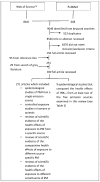A Comparison of the Health Effects of Ambient Particulate Matter Air Pollution from Five Emission Sources
- PMID: 29890638
- PMCID: PMC6024892
- DOI: 10.3390/ijerph15061206
A Comparison of the Health Effects of Ambient Particulate Matter Air Pollution from Five Emission Sources
Abstract
This article briefly reviews evidence of health effects associated with exposure to particulate matter (PM) air pollution from five common outdoor emission sources: traffic, coal-fired power stations, diesel exhaust, domestic wood combustion heaters, and crustal dust. The principal purpose of this review is to compare the evidence of health effects associated with these different sources with a view to answering the question: Is exposure to PM from some emission sources associated with worse health outcomes than exposure to PM from other sources? Answering this question will help inform development of air pollution regulations and environmental policy that maximises health benefits. Understanding the health effects of exposure to components of PM and source-specific PM are active fields of investigation. However, the different methods that have been used in epidemiological studies, along with the differences in populations, emission sources, and ambient air pollution mixtures between studies, make the comparison of results between studies problematic. While there is some evidence that PM from traffic and coal-fired power station emissions may elicit greater health effects compared to PM from other sources, overall the evidence to date does not indicate a clear ‘hierarchy’ of harmfulness for PM from different emission sources. Further investigations of the health effects of source-specific PM with more advanced approaches to exposure modeling, measurement, and statistics, are required before changing the current public health protection approach of minimising exposure to total PM mass.
Keywords: air pollution; health effects; particulate matter; source-specific.
Conflict of interest statement
The authors declare no conflict of interest. The founding sponsors had no role in the writing of the manuscript.
Figures
Similar articles
-
National Particle Component Toxicity (NPACT) Initiative: integrated epidemiologic and toxicologic studies of the health effects of particulate matter components.Res Rep Health Eff Inst. 2013 Oct;(177):5-13. Res Rep Health Eff Inst. 2013. PMID: 24377209
-
Evaluating heterogeneity in indoor and outdoor air pollution using land-use regression and constrained factor analysis.Res Rep Health Eff Inst. 2010 Dec;(152):5-80; discussion 81-91. Res Rep Health Eff Inst. 2010. PMID: 21409949
-
A systematic review on global pollution status of particulate matter-associated potential toxic elements and health perspectives in urban environment.Environ Geochem Health. 2019 Jun;41(3):1131-1162. doi: 10.1007/s10653-018-0203-z. Epub 2018 Oct 8. Environ Geochem Health. 2019. PMID: 30298288
-
Importance of Punctual Monitoring to Evaluate the Health Effects of Airborne Particulate Matter.Int J Environ Res Public Health. 2022 Aug 25;19(17):10587. doi: 10.3390/ijerph191710587. Int J Environ Res Public Health. 2022. PMID: 36078301 Free PMC article. Review.
-
The London low emission zone baseline study.Res Rep Health Eff Inst. 2011 Nov;(163):3-79. Res Rep Health Eff Inst. 2011. PMID: 22315924
Cited by
-
Assessing the impact of aircraft arrival on ambient ultrafine particle number concentrations in near-airport communities in Boston, Massachusetts.Environ Res. 2023 May 15;225:115584. doi: 10.1016/j.envres.2023.115584. Epub 2023 Mar 1. Environ Res. 2023. PMID: 36868447 Free PMC article.
-
Chinese National Air Protection Policy Development: A Policy Network Theory Analysis.Int J Environ Res Public Health. 2018 Oct 15;15(10):2257. doi: 10.3390/ijerph15102257. Int J Environ Res Public Health. 2018. PMID: 30326656 Free PMC article.
-
Risk Factors for Lung Cancer in the Province of Lecce: Results from the PROTOS Case-Control Study in Salento (Southern Italy).Int J Environ Res Public Health. 2022 Jul 19;19(14):8775. doi: 10.3390/ijerph19148775. Int J Environ Res Public Health. 2022. PMID: 35886627 Free PMC article.
-
Ventilation-Associated Particulate Matter Is a Potential Reservoir of Multidrug-Resistant Organisms in Health Facilities.Life (Basel). 2021 Jun 30;11(7):639. doi: 10.3390/life11070639. Life (Basel). 2021. PMID: 34209235 Free PMC article.
-
Application of artificial intelligence in quantifying lung deposition dose of black carbon in people with exposure to ambient combustion particles.J Expo Sci Environ Epidemiol. 2024 May;34(3):529-537. doi: 10.1038/s41370-023-00607-0. Epub 2023 Oct 17. J Expo Sci Environ Epidemiol. 2024. PMID: 37848612 Free PMC article.
References
-
- Cohen A.J., Brauer M., Burnett R., Anderson H.R., Frostad J., Estep K., Balakrishnan K., Brunekreef B., Dandona L., Dandona R., et al. Estimates and 25-year trends of the global burden of disease attributable to ambient air pollution: An analysis of data from the Global Burden of Diseases Study. Lancet. 2017;389:1907–1918. doi: 10.1016/S0140-6736(17)30505-6. - DOI - PMC - PubMed
Publication types
MeSH terms
Substances
LinkOut - more resources
Full Text Sources
Other Literature Sources
Medical



